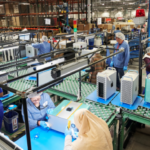US-Based iPhone Manufacturing: Is Apple Really Bringing iPhone Production Home? 2025
Table of Contents
Introduction
“Did you know over 90% of iPhones are still made in China, even in 2025?”
Yep, it’s true—and kind of wild when you think about it. For a brand that’s as American as jeans and road trips, Apple’s most iconic product is still largely built thousands of miles away. But lately, there’s been a shift in the air. Headlines are buzzing. Political leaders are talking. And now, the question is echoing louder than ever: Is Apple finally bringing iPhone production home to the U.S.?
Why does this matter? Because the world has changed. Tensions between global powers are rising, pandemic-era supply chain nightmares still haunt many industries, and companies are starting to rethink the whole idea of “made overseas.” For Apple—a company that thrives on precision, control, and flawless product rollouts—this shift could be huge.
This isn’t just about tech factories or geopolitics. This is about where our favorite devices are born, how secure that process is, and what it means for jobs, prices, and maybe even the iPhone you’ll be holding next year.
Let’s break it down, real-world style. No fluff. Just what’s really going on with Apple’s manufacturing dreams in the U.S., and whether we should believe the hype.

Why iPhones Have Been Made Overseas for So Long
For years, Apple has relied on overseas manufacturing, especially in China, to build its world-famous iPhones. But why exactly has the company kept production so far from home? It all comes down to cost, infrastructure, efficiency — and yes, even politics.
Cheaper Labor and Massive Factory Infrastructure
Let’s face it — labor is significantly cheaper in countries like China compared to the United States. But it’s not just about lower wages. Overseas facilities like Foxconn in Zhengzhou (often referred to as “iPhone City”) have enormous campuses that can house hundreds of thousands of workers and run operations 24/7. This scale is nearly impossible to match in the U.S. — at least, not without enormous investment.
Skilled Labor Force Availability in Places Like China
There’s a long-standing myth that overseas labor is unskilled or only preferred for cost-cutting. The truth? Many Asian countries, especially China, have spent decades developing an expert-level manufacturing workforce. Need 10,000 specialized technicians trained in tooling or micro-soldering? In China, you can find them within days. In the U.S., it might take months — or longer.
Efficiency of Apple’s Supply Chain in Asia
Apple’s supply chain is a finely tuned machine, and it hums loudest in Asia. From chipsets to camera modules, most of the iPhone’s components are designed, tested, and assembled within a few hundred miles of each other. Moving production back to the U.S. would break that chain — or at least, seriously slow it down — and require a complete restructuring that could risk delays and higher costs.
Read More : iPhone 16 & 16 Pro Review: Incremental Upgrades & The AI Promise
Political and Tax Implications
There’s also the reality of international trade policy. Apple has long benefited from favorable tax structures and trade agreements by working with overseas partners. Until recently, it was more advantageous financially to manufacture abroad than in the U.S. While recent political pressure and tariff changes have pushed Apple to reconsider, the cost-benefit equation still isn’t straightforward.
Anecdote: “Back When I Broke My iPhone 6 Screen…”
Back when I broke my iPhone 6 screen — yeah, the whole “pocket drop to face-first pavement” scenario — I took it to a repair shop that sourced its replacement parts directly from Shenzhen. The technician casually told me that Apple’s components and even third-party repair parts all come from a tightly interconnected network overseas. “You want the good stuff?” he said. “It all starts in China.” That moment stuck with me — it wasn’t just about where the iPhone was made, but how deeply rooted its origins were in the East.

What’s Changing Now? Apple’s Big Moves Toward US-Based Manufacturing
Apple has long been known for designing its sleek, powerful devices in California, while assembling them across the world—mostly in China. But things are starting to shift. In the past couple of years, and especially in 2024, we’ve seen some concrete steps that suggest Apple may be serious about bringing more of its iPhone manufacturing operations to the United States.
Recent News of US Investment in iPhone Components
One of the most notable developments is Apple’s multi-billion-dollar investment in American-made iPhone components. These aren’t just symbolic moves—Apple is putting real money into the domestic supply chain. The company has announced plans to source more components, like chips and semiconductors, from within the U.S., which could significantly reduce reliance on overseas production.
TSMC Factories in Arizona
Perhaps the most talked-about milestone is the construction of Taiwan Semiconductor Manufacturing Company (TSMC) factories in Arizona. TSMC is Apple’s primary chipmaker, and its Arizona plant will be producing advanced 3-nanometer chips—the same kind that power the latest iPhones. While the factory isn’t fully operational yet, the fact that Apple is aligning itself so closely with domestic chip production is a massive signal.
This move could bring a chunk of Apple’s supply chain closer to home, potentially increasing resilience and reducing logistical risks associated with overseas manufacturing.
Partnerships with Local Suppliers
In addition to chips, Apple is expanding partnerships with U.S.-based suppliers for other parts of the iPhone. Companies like Corning (maker of the ultra-durable glass for iPhones) and Finisar (which produces components for Face ID) are getting more attention—and funding—from Apple. These collaborations suggest a growing trend toward local sourcing and investment in American manufacturing talent and infrastructure.
Government Incentives Like the CHIPS Act
Federal support has played a major role in this shift. The CHIPS and Science Act, signed into law in 2022, offers billions in subsidies and tax incentives for companies that build semiconductor manufacturing plants in the U.S. Apple, along with partners like TSMC, stands to benefit from these policies.
The CHIPS Act has not only motivated construction of new fabs but also sparked wider conversations about national security, technological independence, and job creation—topics that align with Apple’s public push for a more American-centered supply chain.
Tangent: “I remember when Made in USA labels were everywhere…”
For many Americans, this news taps into something deeper than tech—it’s a bit nostalgic. There was a time when “Made in USA” labels proudly adorned everything from toasters to televisions. Now, seeing that phrase on an iPhone—even if just for a component—feels significant. It stirs up memories of a time when American manufacturing was the backbone of the economy, and it opens up new hopes for what the future could look like.

The Challenges of Making iPhones in the USA
While the idea of assembling iPhones on American soil sounds patriotic and promising, the reality is far more complex. Several significant hurdles stand in Apple’s way if it chooses to bring large-scale iPhone manufacturing to the United States.
1. Higher Labor Costs
One of the biggest challenges is the dramatically higher labor costs in the U.S. Compared to countries like China, where manufacturing wages are lower, hiring American workers for similar roles would significantly increase production costs. This could mean either slimmer margins for Apple or higher prices for consumers—neither of which aligns with Apple’s long-term strategy.
2. Lack of Skilled Large-Scale Assembly Workers
Assembling an iPhone isn’t a simple task. It requires highly specialized skills and experience in large-scale electronic assembly. The U.S. workforce currently lacks the volume of skilled labor that’s needed to build millions of complex devices quickly and efficiently. China, on the other hand, has trained hundreds of thousands of workers for exactly this kind of production.
3. Supply Chain Disruption
The iPhone supply chain is a finely tuned, global operation. Everything from chips to screens comes from specialized suppliers scattered across Asia. Relocating production to the U.S. would likely disrupt this carefully balanced supply chain, increasing the risk of delays, shortages, and added costs due to longer logistics chains.
4. Environmental and Zoning Issues
Building new manufacturing facilities in the U.S. isn’t just expensive—it’s also highly regulated. Navigating environmental laws, obtaining zoning permits, and satisfying local communities takes time and resources. In some regions, pushback from residents concerned about pollution or noise could further slow down any attempt to bring iPhone factories stateside.
5. Frustration Moment: A Personal Glimpse
Let’s not forget how hard it is to even find basic parts for a DIY repair in the U.S., let alone manufacture an entire phone.
“Tried sourcing tech parts for a DIY phone fix once—nightmare!”
If getting a single replacement chip or connector feels impossible, imagine the scale of difficulty in producing the entire iPhone here.

Benefits of US-Based iPhone Production
Job Creation
One of the most immediate and visible benefits of iPhone production in the U.S. is job creation. From skilled manufacturing roles to supply chain logistics and local support services, bringing production stateside could provide thousands of employment opportunities. This boost could revitalize regions with a strong industrial past while helping stimulate the broader American economy.
National Security and IP Protection
Keeping iPhone production within the United States allows Apple to better protect its trade secrets and intellectual property. With growing concerns over data privacy, cybersecurity threats, and IP theft, producing devices domestically provides an extra layer of security—especially important for a company that handles massive amounts of user data.
Read More : Ahead of 104% China Tariff, Trump Pushes for US-Based iPhone Manufacturing
Reduced Dependency on Geopolitically Tense Regions
Apple’s current supply chain heavily relies on countries like China and Taiwan—areas often affected by geopolitical tensions. Shifting some production to the U.S. could help Apple minimize risks associated with international conflict, trade restrictions, and tariffs, making its operations more resilient and future-proof.
Closer Oversight and Quality Control
Producing iPhones in the U.S. would allow Apple to keep a closer eye on every step of the process, from design to final assembly. This could lead to even higher levels of quality assurance and better response times when addressing production challenges. It also helps reinforce Apple’s commitment to ethical labor practices and environmental standards.
Pride in Domestic Innovation
“Made in the USA” still carries weight—and pride—for many consumers. Domestic iPhone production could enhance Apple’s brand image by positioning the company as a leader in American innovation and manufacturing. It taps into consumer desire for ethically made, high-quality tech products that support local economies and craftsmanship.

What This Means for Consumers (Yep, That’s You and Me)
Potential Price Changes (And Not the Good Kind…)
Let’s be real here—if Apple moves its iPhone production back to the U.S., there’s a chance we’ll see the prices go up. Manufacturing in the U.S. could come with higher labor costs, stricter regulations, and potentially more expensive raw materials. While it might seem like a great idea to have all our gadgets made at home, those costs tend to trickle down to us, the consumers. So, don’t be surprised if the next iPhone launch comes with a higher price tag, and yes, that could be a little painful.
Shorter Delivery Times
On the flip side, producing iPhones domestically could mean faster delivery times for those of us who can’t wait to get our hands on the latest tech. No more long shipping delays from overseas factories. Instead, we might see quicker turnarounds for repairs, replacements, or new purchases. Imagine ordering your iPhone and getting it delivered in days instead of weeks. That’s definitely a win for the impatient among us!
Ethical Buying Appeal
Let’s talk ethics. Many consumers are becoming more conscious about the environmental and social impacts of their purchases. If Apple brings iPhone production back to the U.S., it could help boost the appeal of buying an iPhone for people who care about ethical manufacturing. Supporting local jobs, reducing carbon footprints with shorter shipping distances, and contributing to American economies might be a big draw for some.
Supporting Local Economies
Speaking of local economies, bringing iPhone production home could provide a big boost to U.S. manufacturing jobs. That means more opportunities for workers in the tech and manufacturing sectors. For Apple, it’s a chance to show they’re supporting the U.S. economy, and for consumers, it could feel good knowing your purchase is helping create jobs right in your own backyard.
Real Talk: “Would I Pay $100 More for a U.S.-Made iPhone? Depends on the Day…”
But here’s the real kicker: Would I (or you) be willing to pay $100 more for a U.S.-made iPhone? Honestly, it’s a tough call. Some days, I’d be all in—proud to support local production and feel like my purchase is helping the economy. Other days, though, when I’m trying to stick to a budget, I might rethink it. At the end of the day, it’s all about balancing the price tag with the benefits of having a high-tech device made closer to home.
Conclusion
To recap, Apple is indeed experimenting with US-based manufacturing, but we’re still far from a fully American iPhone. While the move to diversify production is a step forward in reshaping global supply chains, it’s important to recognize that many aspects of the iPhone’s production will likely remain overseas for the foreseeable future. Apple’s push for more domestic manufacturing is part of a broader strategy to mitigate risks and possibly gain political and economic advantages. However, this shift is a gradual process, not an overnight change.
Now, take a moment to think about your own tech purchases. Does knowing where your devices are made influence your buying decisions? Whether you prioritize local production or value other factors like cost and features, it’s clear that how products are made plays a role in shaping our choices as consumers.
Have you ever checked where your tech is made? Share your take in the comments! Let’s discuss how this affects our buying habits and what it might mean for the future of technology.
- How to Improve Battery Life on Your Laptop
 How to Improve Battery Life on Your Laptop (Real Tips That Actually Work!) Introduction “My battery died in the middle of a Zoom interview. I wanted to cry.” We’ve all …
How to Improve Battery Life on Your Laptop (Real Tips That Actually Work!) Introduction “My battery died in the middle of a Zoom interview. I wanted to cry.” We’ve all … - Google Pixel 9a vs iPhone 16e: The Ultimate $500 Mid-Range Battle
 Google Pixel 9a vs iPhone 16e: The Ultimate $500 Mid-Range Battle Introduction In 2025, the smartphone mid-range battlefield just got a lot more exciting with the release of two contenders …
Google Pixel 9a vs iPhone 16e: The Ultimate $500 Mid-Range Battle Introduction In 2025, the smartphone mid-range battlefield just got a lot more exciting with the release of two contenders … - Oppo Find X8 Ultra: My 2025 Dream Phone Brought to Life
 Oppo Find X8 Ultra: My 2025 Dream Phone Brought to Life Introduction All right, let’s get real—I’ve been asked countless times over the years, “What’s your dream phone?” And usually, …
Oppo Find X8 Ultra: My 2025 Dream Phone Brought to Life Introduction All right, let’s get real—I’ve been asked countless times over the years, “What’s your dream phone?” And usually, … - Acer Aspire Go 15 (AG15-51P) Review
 Acer Aspire Go 15 (AG15-51P) Review: Budget-Friendly Performance Unveiled Introduction Did you know that budget laptops now offer features once reserved for premium models? The Acer Aspire Go 15 (AG15-51P) …
Acer Aspire Go 15 (AG15-51P) Review: Budget-Friendly Performance Unveiled Introduction Did you know that budget laptops now offer features once reserved for premium models? The Acer Aspire Go 15 (AG15-51P) … - US-Based iPhone Manufacturing: Is Apple Really Bringing iPhone Production Home?
 US-Based iPhone Manufacturing: Is Apple Really Bringing iPhone Production Home? 2025 Introduction “Did you know over 90% of iPhones are still made in China, even in 2025?”Yep, it’s true—and kind …
US-Based iPhone Manufacturing: Is Apple Really Bringing iPhone Production Home? 2025 Introduction “Did you know over 90% of iPhones are still made in China, even in 2025?”Yep, it’s true—and kind …



